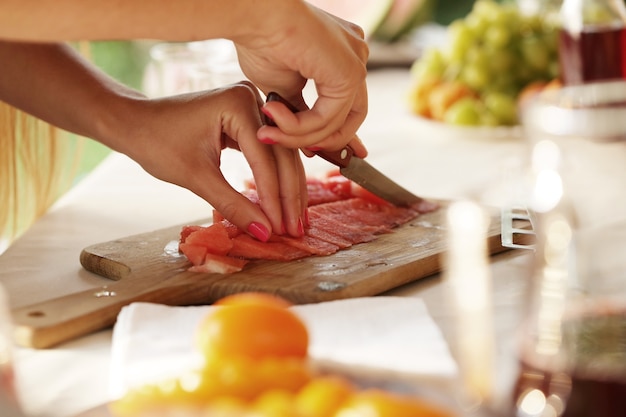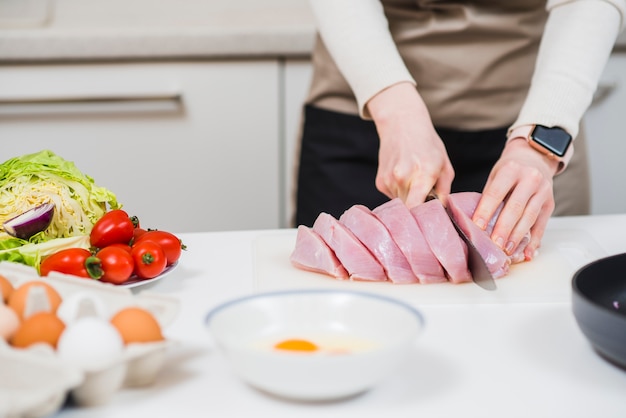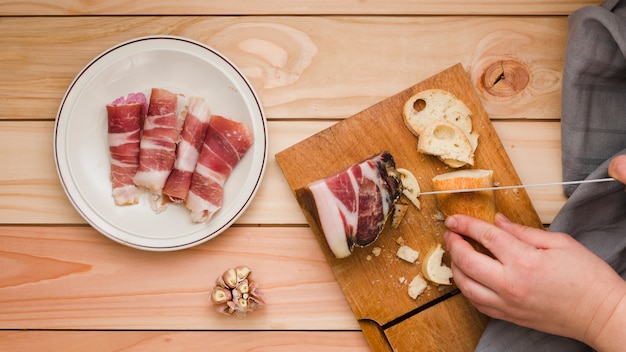Ah, ham. It's a classic dish that always brings a sense of occasion, whether it's a festive feast or a casual Sunday lunch. A good ham is a real crowd-pleaser, but let's be honest, cooking one can feel a bit daunting. You've got all these different cooking times and temperatures swirling around in your head, and you're worried about ending up with a dry, overcooked, or undercooked ham. Fear not, my friend! I've been there, done that (and worn the apron, too).
Over the years, I've experimented with all sorts of ham-cooking techniques, and I've learned a thing or two about how to get that perfectly cooked, juicy, and flavourful ham every time. So, grab your favourite beverage (a nice cuppa, perhaps?), get comfy, and let's dive into the world of ham cooking, together.
(Part 1) Choosing the Right Ham: Your Ham-tastic Adventure Begins!

The journey to a perfect ham starts right at the beginning, with choosing the right one. There are so many different types of ham out there, and it's important to pick one that's going to suit your needs and taste buds.
Types of Ham: A Culinary Safari
First, you need to know what kind of ham you want. There are two main types:
- fresh ham: These are raw and require a longer cooking time. They're typically found in the butcher’s section of the supermarket and offer a more intense flavour. You'll need to plan ahead for a longer cooking time if you choose this option.
- cured ham: These have been cured with salt, sugar, and sometimes other flavourings. They come in various forms, including:
- pre-cooked ham: These are already fully cooked and just need to be reheated. They're a great option if you're short on time or want a simple meal. You can get them bone-in or boneless, and they often come with a glaze.
- spiral-sliced ham: These are pre-cooked and ready to eat, but they can also be reheated for a more tender texture. They are perfect for easy carving and a more convenient option for gatherings.
- dry-cured ham: These are cured for a longer period and are usually more salty and intense in flavour. They often have a more robust, rustic flavour, and are typically enjoyed thinly sliced.
Choosing the Right Size: A Ham-sized Calculation
Once you've chosen the type of ham you want, think about how many people you're cooking for. You don’t want to be left with too much leftover ham (although, that’s never a bad thing, really!). A good rule of thumb is to allow about 1/2 pound of ham per person. But if you’re the type who loves leftover ham for sandwiches and breakfast, then you might want to go a little heavier.
Bone-In or Boneless: A Decision of Flavor and Convenience
bone-in hams have more flavour because the bone helps to keep the meat moist during cooking. They’re also a little more economical. However, boneless hams are easier to carve and can be cooked in a shorter time.
(Part 2) Cooking the Ham: A Step-by-Step Guide to Ham-tastic Success

Now, for the fun part! Cooking the ham. Here's what you need to do:
Preheat Your Oven: Setting the Stage for a Perfect Ham
First things first, get your oven preheated. The temperature you need will depend on whether you're cooking a fresh or a pre-cooked ham. For fresh ham, you’ll need a higher temperature, around 325°F (160°C). Pre-cooked hams are best cooked at a lower temperature, around 275°F (135°C).
Prepare the Ham: Getting Your Ham Ready for its Culinary Debut
Now, let's get that ham ready. If you're using a pre-cooked ham, you can skip this step. However, if you're cooking a fresh ham, you need to give it a good wash and pat it dry with paper towels. Then, you’ll need to score it. Scoring is just a fancy word for making small cuts across the fat of the ham. This allows the fat to render during cooking, which keeps the ham juicy and flavorful.
Season the Ham: Adding a Touch of Magic
Now, it’s time to get creative and add some flavour. You can use a simple salt and pepper rub, or get fancy with a mixture of herbs and spices. I love using a blend of garlic powder, paprika, brown sugar, and a pinch of cayenne pepper for a little kick. You can also add a glaze to your ham. There are endless possibilities here, from a simple honey glaze to a more complex glaze made with mustard, brown sugar, and orange juice.
Cook the Ham: The Culinary Transformation
Now, let's get cooking! Place the ham in a roasting pan and add a little bit of water to the bottom of the pan. This helps to create steam and keeps the ham moist. Cook the ham for the recommended time, based on its weight.
Here's a handy table to give you a rough idea of how long to cook a ham, based on its weight:
| Ham Weight | Cooking Time (Fresh Ham) | Cooking Time (Pre-Cooked Ham) |
|---|---|---|
| 10-12 pounds | 3-4 hours | 1-2 hours |
| 12-14 pounds | 4-5 hours | 2-3 hours |
| 14-16 pounds | 5-6 hours | 3-4 hours |
Check the internal temperature: Ensuring Ham-tastic Perfection
The best way to know if your ham is cooked through is to use a meat thermometer. For fresh ham, the internal temperature should reach 145°F (63°C). For pre-cooked ham, the internal temperature should reach 140°F (60°C).
Rest the Ham: Allowing the Flavors to Settle
Once your ham is cooked, let it rest for about 15 minutes before carving. This allows the juices to redistribute, resulting in a more tender and juicy ham.
(Part 3) Tips and Tricks for Perfect Ham: Level Up Your Ham-Cooking Skills

Here are a few tips and tricks that I've picked up over the years. They'll help you take your ham cooking to the next level.
Use a Ham Holder: Ensuring Even Cooking
A ham holder makes it easier to cook the ham evenly and helps to prevent it from drying out. Just place the ham in the holder and place it in the roasting pan.
Baste the Ham: Adding Moisture and Flavor
Basting the ham with its own juices or with a glaze during cooking helps to keep it moist and flavorful. You can baste it every 30 minutes or so.
Don't Overcook the Ham: Avoiding a Dry Ham
Overcooked ham is dry and tough. So, make sure you don't cook it for too long. Follow the cooking time guidelines, and check the internal temperature regularly.
Make a Glaze: Adding a Touch of Sweetness and Shine
A glaze adds extra flavour and a beautiful finish to your ham. You can use a store-bought glaze, or you can make your own. Here's a simple honey glaze recipe:
- 1/2 cup honey
- 1/4 cup brown sugar
- 1 tablespoon Dijon mustard
- 1 teaspoon ground ginger
- 1/2 teaspoon garlic powder
- 1/4 teaspoon black pepper
Combine all of the ingredients in a saucepan and bring to a simmer over medium heat. Simmer for 5 minutes, or until the glaze has thickened slightly. Then, brush the glaze over the ham during the last 30 minutes of cooking.
(Part 4) Serving and Storing Ham: Bringing Your Ham to the Table
Now that your ham is cooked to perfection, it’s time to serve it up! Here are a few tips for serving and storing your ham.
Serving the Ham: A Ham-tastic Presentation
Carve the ham into thin slices, and serve it hot with your favourite sides. A classic combination is ham with roasted vegetables, mashed potatoes, and gravy. But you can also get creative and serve it with other sides like baked beans, cornbread, or coleslaw.
Storing Leftover Ham: Preserving the Ham-tastic Flavors
Leftover ham can be stored in the refrigerator for up to 4 days. Wrap it tightly in plastic wrap or aluminum foil. You can also freeze leftover ham for up to 2 months. To freeze ham, wrap it tightly in plastic wrap and then in aluminum foil.
(Part 5) Variations on Ham: Expanding Your Culinary Horizons
Now that you've mastered the art of cooking a simple ham, let's explore some exciting variations!
Ham with Pineapple: A Sweet and Savory Delight
This is a classic combination that's always a crowd-pleaser. Simply place pineapple slices on top of the ham during the last hour of cooking. The sweetness of the pineapple pairs perfectly with the salty ham.
Glazed Ham with Brown Sugar: A Sweet and Sticky Treat
For a sweet and sticky glaze, combine brown sugar, honey, and a bit of mustard. Brush the glaze over the ham during the last 30 minutes of cooking.
Spiced Ham with Chili Powder: A Spicy Kick
Add a touch of heat to your ham by rubbing it with a spice blend that includes chili powder, cumin, and paprika. You can also use a smoked paprika for an even smokier flavour.
Ham with Apricots: A Touch of Sweet and Tart
Apricots are a delightful addition to ham. They add a touch of sweetness and tartness. Place apricot halves on top of the ham during the last 30 minutes of cooking.
Ham with Cherries: A Festive Twist
Sweet and tart cherries are another great pairing for ham. They add a touch of sweetness and a beautiful colour to the ham. Place cherry halves on top of the ham during the last 30 minutes of cooking.
(Part 6) Ham in Other Dishes: Beyond the Roast
Ham is a versatile ingredient and can be used in many different dishes, beyond just roasting. Here are a few ideas to get you started:
Ham and pea soup: A Hearty and Comforting Dish
This hearty soup is perfect for a cold winter day. Simply simmer diced ham, peas, carrots, potatoes, and onions in a pot of broth.
ham and cheese quiche: A Classic and Versatile Option
This classic quiche is always a crowd-pleaser. Simply layer diced ham, cheese, and vegetables in a pie crust and bake until golden brown.
Ham and bean soup: A Flavorful and Filling Meal
This hearty soup is packed with protein and fibre. Simmer diced ham, beans, tomatoes, and onions in a pot of broth.
Ham and Broccoli Casserole: A Quick and Easy weeknight dinner
This easy casserole is perfect for a weeknight meal. Simply layer cooked ham, broccoli, cheese sauce, and breadcrumbs in a casserole dish and bake until golden brown.
(Part 7) Ham and Its History: A culinary journey Through Time
So, where does this delicious meat come from? Ham has a fascinating history, dating back thousands of years!
Origins in Ancient Times: A Ham-tastic Past
The earliest evidence of ham production dates back to ancient Egypt, where people preserved meat by salting and drying it. In ancient Rome, ham was a popular food, and they even had a special type of ham called "ham of Parma."
Ham in Medieval Europe: A Staple Food for Centuries
In medieval Europe, ham was a staple food, especially for the peasantry. It was preserved by smoking and salting, which allowed it to last for months.
Ham in the Americas: A culinary legacy
Ham arrived in the Americas with the early European settlers. It quickly became a popular food, and it was often served at feasts and celebrations.
Ham Today: A Culinary Classic
Today, ham is still a popular food all over the world. It's a versatile ingredient that can be used in countless dishes, from simple roasts to sophisticated gourmet creations.
(Part 8) FAQs: Solving Your Ham-Cooking Questions
Here are some commonly asked questions about cooking ham.
1. How do I know if my ham is cooked?
The best way to know if your ham is cooked is to use a meat thermometer. For fresh ham, the internal temperature should reach 145°F (63°C). For pre-cooked ham, the internal temperature should reach 140°F (60°C).
2. Can I cook ham in a slow cooker?
Yes, you can cook ham in a slow cooker. It's a great way to get a tender and juicy ham. Simply place the ham in the slow cooker and cook on low for 6-8 hours, or on high for 3-4 hours.
3. How do I reheat leftover ham?
You can reheat leftover ham in the oven, microwave, or on the stovetop. To reheat ham in the oven, wrap it in aluminum foil and bake at 325°F (160°C) for 15-20 minutes. To reheat ham in the microwave, cover it with a damp paper towel and microwave on high for 1-2 minutes. To reheat ham on the stovetop, place it in a skillet with a little bit of water and cook over medium heat for 5-10 minutes.
4. How do I make a ham glaze?
A ham glaze is a delicious and easy way to add flavour and a beautiful finish to your ham. Here are a few glaze recipes:
- Honey Glaze: Combine 1/2 cup honey, 1/4 cup brown sugar, 1 tablespoon Dijon mustard, 1 teaspoon ground ginger, 1/2 teaspoon garlic powder, and 1/4 teaspoon black pepper.
- maple glaze: Combine 1/2 cup maple syrup, 1/4 cup brown sugar, 1 tablespoon Dijon mustard, 1 teaspoon ground cinnamon, and 1/4 teaspoon ground nutmeg.
- brown sugar glaze: Combine 1 cup brown sugar, 1/4 cup water, 1/4 cup apple cider vinegar, 1/4 cup orange juice, and 1/4 teaspoon ground cloves.
Simply brush the glaze over the ham during the last 30 minutes of cooking.
5. How long can I keep leftover ham in the fridge?
You can keep leftover ham in the refrigerator for up to 4 days. Wrap it tightly in plastic wrap or aluminum foil.
So, there you have it, my friends! My comprehensive guide to cooking the perfect ham. I hope you've learned a thing or two, and I can't wait to see your ham-cooking masterpieces. Remember, the key to a perfect ham is to choose the right ham, cook it to the right temperature, and don't be afraid to get creative with your flavouring. Happy ham-cooking!
Everyone is watching

Prime Rib Roast Cooking Time Chart: Per Pound Guide
Cooking TipsPrime rib roast. Just the name conjures images of lavish dinners, crackling fires, and hearty laughter. It’s ...

How Long to Bake Potatoes in the Oven (Perfect Every Time)
Cooking TipsBaked potatoes are a staple in my kitchen. They're incredibly versatile, delicious, and surprisingly easy to m...

Perfect Rice Every Time: The Ultimate Guide to Cooking Rice
Cooking TipsAs a self-proclaimed foodie, I've always been a bit obsessed with rice. It's the foundation of countless cuisi...

The Ultimate Guide to Cooking Asparagus: Tips, Techniques, and Recipes
Cooking TipsAsparagus. The mere mention of this spring delicacy conjures up images of vibrant green spears, crisp and burs...

Ultimate Guide to Cooking the Perfect Thanksgiving Turkey
Cooking TipsThanksgiving. Just the word conjures up images of overflowing tables laden with delicious food, the scent of r...
